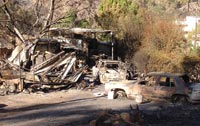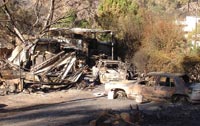
Preventing Another Firestorm
After the California wildfires, wireless security is key to rebuilding
- By David Mitchell
- May 21, 2008
 The task of rebuilding has
begun after the Southern
California wildfires left nearly
a half-million acres
scorched last year. With more than 1,500
homes lost and well over $1 billion in
insured losses, one of the greatest challenges
for those starting over will be getting
adequate insurance against future
fires. If insurers balk at taking another
chance on areas long prone to such outbreaks,
the possibility of restoring the residential
communities is dim. However,
innovations in IP-based wireless surveillance
cameras may prove key to effectively
managing the risks.
The task of rebuilding has
begun after the Southern
California wildfires left nearly
a half-million acres
scorched last year. With more than 1,500
homes lost and well over $1 billion in
insured losses, one of the greatest challenges
for those starting over will be getting
adequate insurance against future
fires. If insurers balk at taking another
chance on areas long prone to such outbreaks,
the possibility of restoring the residential
communities is dim. However,
innovations in IP-based wireless surveillance
cameras may prove key to effectively
managing the risks.
In Laguna Beach, south of Los
Angeles, this technology is already in
place, adding a powerful tool to enhance
community fire watch efforts. The
Laguna FireSafe Council was created
after the 1993 firestorms destroyed more
than 300 homes with a combined loss in
excess of $500 million. By the mid-
1990s, the organization created the Red
Flag patrol, a group of more than 100 volunteers
who patrol the region during
high-risk periods when dry conditions
and the Santa Ana winds make for a
potentially deadly combination. Working
with the local fire department, the volunteers
have provided extra lookout in and
around the area.
Adapting an Idea
The idea for this application began with a
different installation. Three years ago,
Pro911 Systems installed a series of Sony
IPELA® SNC-RZ25N cameras linked by
a Tropos® wireless network to serve as a
force extender to aid the patrol along
Laguna and Newport beaches. The system
provides immediate, real-time access
to what’s happening and allows rescuers
to arrive on the scene at incidents faster
and better than possible through previous
methods. With the wireless surveillance
system, the staff can zoom in to quickly
assess the situation and send out appropriate
help immediately.
The combination of cameras and a
wireless network opens up new dimensions
to video surveillance, enabling applications
unimaginable with the old CCTV infrastructure.
The ability to position and access
cameras anywhere creates flexible tools
that effectively allow eyeball situations
whenever and wherever. Not long ago, the
idea of wireless video seemed distant given
the bandwidth requirements. But the mesh
network is a robust broadband conduit that
is a perfect match with the camera’s efficient
use of the network’s capacity.
Together, wireless video surveillance is
suddenly a reality with tremendous, unexplored
possibilities.
After this introduction to the technology,
the idea of using IP-based wireless
video surveillance for firewatchers seems
obvious. Laguna Beach residents are
acutely aware of the fire risks. In 2005,
users began exploring how to use it as a
force extender for the Red Flag patrol.
Now, the Laguna FireSafe Council, working
with Pro911 Systems and the Laguna
Broadcast Network, a local wireless
broadband provider, has demonstrated
the proof-of-concept with an initial
implementation. Funds from a $10,000
grant from the Bureau of Land
Management have paid for two fixedangle
cameras strategically positioned at
the edge of the wildland-urban interface
where wildfires typically start. The best
of what’s called “woo-wee watching” will
soon come from additional cameras that
will be positioned atop 16-foot poles.
These will be self-contained systems that
operate off solar-power-charged battery
packs in the more remote areas.
What the system adds is extra eyes on
the most crucial areas. Local fire officials
also can access the system.
Challenges to Implementation
The major challenges for full implementation
of the system aren’t technological.
Laguna Broadcast Network’s high-speed
Tropos wireless mesh extends throughout
the area, making it easy to receive highquality
video imaging from the IPELA
robotic cameras anywhere in the region.
The SNC-RZ25N’s selectable JPEG and
MPEG-4 compression allows for optimal
use of the bandwidth. Wireless capabilities
come through a wireless card installed in
the unit’s industry-standard Compact
Flash® card slot.
Instead, much of the work involves
educating residents and officials about
what this offers, as well as answering
their concerns. First, homeowners within
range of the system are sometimes apprehensive
about maintaining their privacy.
This is easily addressed since the Sony
cameras are equipped with a feature
called “privacy-zone masking.” Private
property within the field of view can be
blocked from the camera’s PTZ range.
With this, only the public spaces are within
reach.
Another challenge has been getting
permits from county park officials. Since
this is a new concept, this has required an
educational outreach to assure them that
the impact on the wildlife areas is minimal.
In fact, an unexpected, added benefit
comes with the ability to use the system
during downtime to better understand the
wildlife inhabiting these areas.
Widespread Deployment
Of course, following the recent destruction,
the need for such systems is abundantly
clear. The current implementation
does not record visual data, but that may
change to help deter arson and to investigate
incidents if they should happen.
The initial experience implementing a
fire watch system using wireless IP-based
surveillance technology to support the
Laguna FireSafe Council lays the groundwork
for widespread adoption. Aside from
the added protection this can provide, the
investment in this technology may be the
most cost-effective to assure insurance
providers that such advances provide the
necessary means to control fire risks. In
fact, the cost for such systems is minuscule
in the context of potential multibillion
dollar losses. Public support also comes
with the understanding that getting any
coverage may well be contingent on such
systems or that there may be a return on
investment through reduced insurance
rates. As the ability for these systems
becomes apparent,
they should catch on
like, well, wildfire.